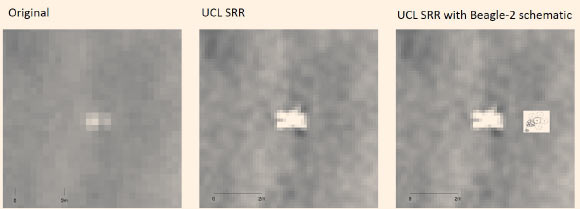The Martian surface — including the location of ESA’s Beagle-2 lander, and the ancient lakebeds discovered by NASA’s Curiosity rover — has been shown in unprecedented detail by planetary researchers at University College London (UCL).

Beagle-2 landing site: original image (upper panel) and SRR from 5 input images (lower). The bright object in the upper centre portion is shown in the next figure. Map co-ordinates come from NASA’s HiRISE camera and are not in a global reference system. Image credit: Yu Tao & Jan-Peter Muller, University College London.
According to Prof. Jan-Peter Muller from the UCL Mullard Space Science Laboratory and Yu Tao, a researcher at UCL, the technique they developed — called Super-Resolution Restoration (SRR) — could be used to search for other artifacts from past failed landings as well as identify safe landing locations for future rover missions.
A paper describing the SRR technique was published in the February issue of the journal Planetary and Space Science.
“We now have the equivalent of drone-eye vision anywhere on the surface of Mars where there are enough clear repeat pictures,” Prof. Muller said.
“It allows us to see objects in much sharper focus from orbit than ever before and the picture quality is comparable to that obtained from landers.”
“As more pictures are collected, we will see increasing evidence of the kind we have only seen from the three successful rover missions to date. This will be a game-changer and the start of a new era in planetary exploration,” he said.
For cameras orbiting Earth and Mars, the resolution limit today is around 10 inches (25 cm).
By stacking and matching pictures of the same area taken from different angles, SRR allows objects as small as 2 inches (5 cm) to be seen from the same 25-cm telescope.
For the Red Planet, where the surface usually takes decades to millions of years to change, these images can be captured over a period of ten years and still achieve a high resolution.
For Earth, the atmosphere is much more turbulent so images for each stack have to be obtained in a matter of seconds.

Zoom-up of the proposed Beagle-2 location (left panel) at the original 25 cm resolution; zoom-up of the SRR of proposed lander location (center panel) at 6.25 cm; cartoon sketch of Beagle-2 superimposed on the right of the proposed lander location at the same scale on SRR (right panel). Image credit: University College London.
Tao and Prof. Muller applied SRR to stacks of between four and eight 10 inch images of the Martian surface taken using the High Resolution Imaging Science Experiment (HiRISE) — a camera on board NASA’s Mars Reconnaissance Orbiter — to achieve the 2 inch target resolution. These included some of the latest images of the Beagle-2 landing area.
“Our technique has huge potential to improve our knowledge of a planet’s surface from multiple remotely sensed images,” Tao said.
“In the future, we will be able to recreate rover-scale images anywhere on the surface of Mars and other planets from repeat image stacks.”
The team plans on exploring other areas of Mars using the SRR technique to see what else they find.
_____
Y. Tao & J.-P. Muller. 2016. A novel method for surface exploration: Super-resolution restoration of Mars repeat-pass orbital imagery. Planetary and Space Science, vol. 121, pp. 103-114; doi: 10.1016/j.pss.2015.11.010







